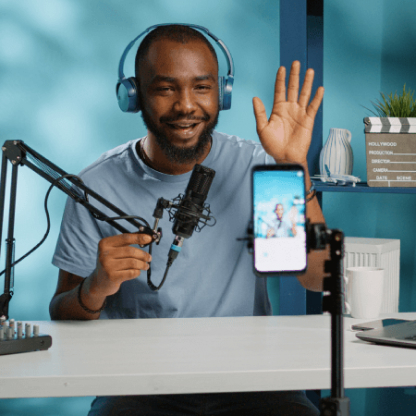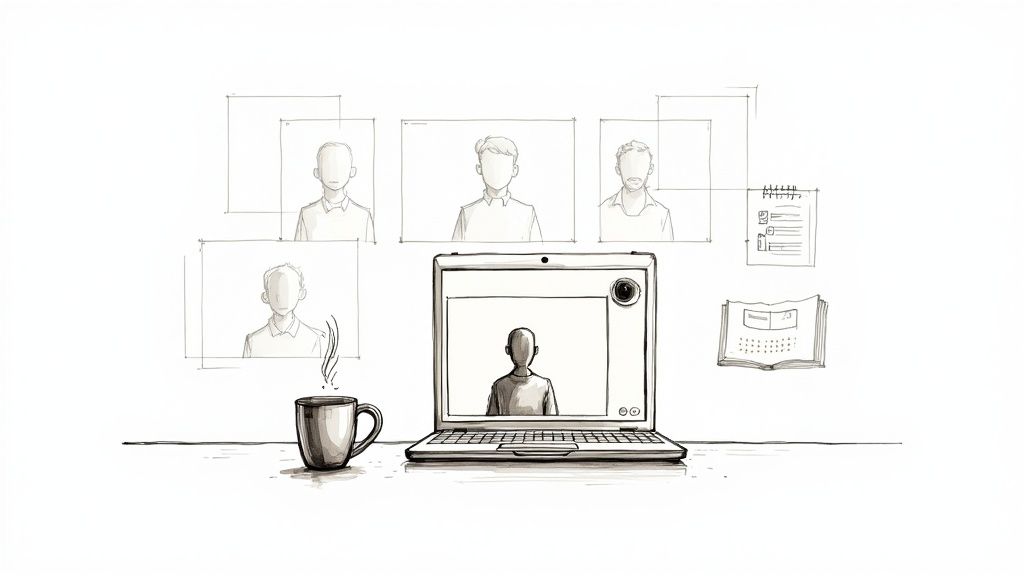Shortlisting of candidates is the brutal, necessary process of turning a mountain of applications into a handful of people you actually want to talk to. It's the bouncer at the door of your interview process, and frankly, most bouncers are too slow and let the wrong people in.
Think of it as the one step that saves you from drowning in a sea of "highly motivated team players" who can't do the job.
Why Your Resume Pile Is a Graveyard of Good Intentions
Let's be real. That 'maybe' pile on your desk? It's where great candidates go to die. You start Monday with a hundred hopeful PDFs and end Friday with a slightly smaller pile, a massive headache, and a sneaking suspicion you missed someone great. This isn't just inefficient; it's a fundamentally broken way to build a team.
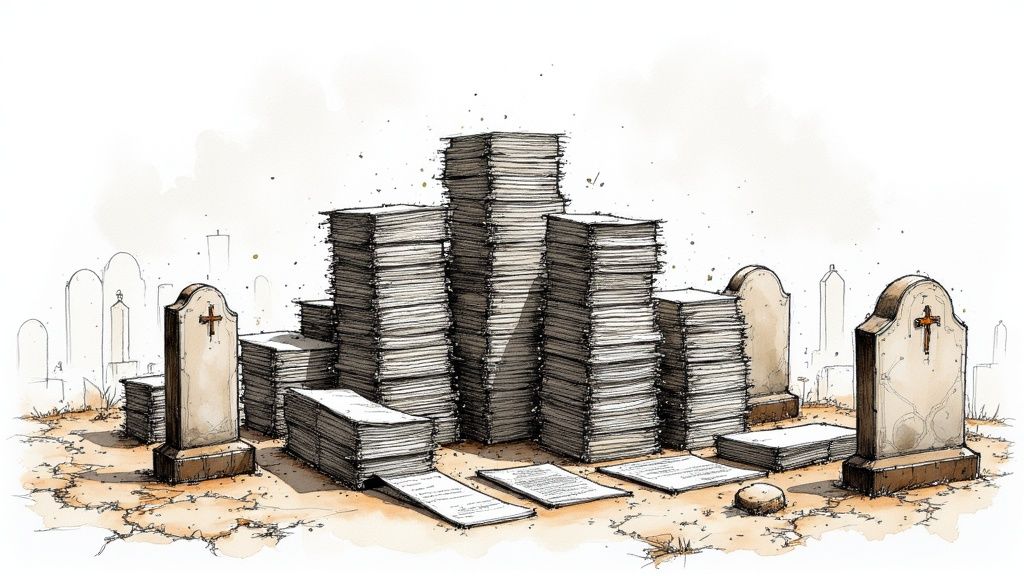
This manual mess was designed for an era before one job post could attract applicants from three different continents overnight. Today, an average open position gets around 74 applicants. Out of that chaos, a tiny 4.3% will even land an interview. This shows just how critical a ruthless shortlist is for finding the gems before they’re gone.
The Real Cost of "Manual" Shortlisting
You think you’re being thorough, but you’re really just burning cash. Every hour you spend manually squinting at resumes is an hour you're not spending talking to the high-impact people who could actually change your company's trajectory.
The true cost isn't just time, either. It’s what you lose in the chaos:
- Lost Talent: The perfect candidate applied on day one. But by the time you dig their resume out from the bottom of the pile two weeks later, they’ve already accepted an offer from your competitor. Game over. You lose.
- Team Burnout: Your hiring managers are drowning. They're becoming professional resume-skimmers, not the strategic talent partners you hired them to be. Hope you enjoy your best people spending their days fact-checking university dates.
- Decision Fatigue: After scanning the 50th resume from a "results-driven go-getter," everyone starts to look the same. You start making calls based on gut feelings and keyword bingo, not actual potential.
This entire manual ritual is the first step toward a bad hire. When you rush the shortlisting process because you're exhausted, you end up interviewing the most polished resume writers, not the best problem-solvers.
The goal isn't just to make the pile smaller. It's to build a smarter, faster filter that surfaces the right people from the jump.
This is fundamentally what pre-screening is all about, and you can learn more about setting up an effective pre-screening process in our guide. It's time to fix the part of hiring that everyone secretly hates.
How to Spot Real Talent (When Everyone's a "Rockstar")
Alright, you’ve got a mountain of resumes. Now the real work begins.
Effective shortlisting of candidates isn't about finding people who check a few boxes. It's about confidently rejecting the wrong ones without accidentally tossing a future star into the 'no' pile. This is precisely where most hiring processes fall apart.

So how do you tell a genuine problem-solver from a professional buzzword-collector? You need a system. A ruthless one.
First, Define Your Deal-Breakers
Before you even glance at a single resume, you need to know your non-negotiables. I’m not talking about a nice-to-have wish list; I mean the absolute, must-have criteria for someone to even survive in this role. If you can't nail this down, you’ll drown in a sea of "maybes."
Get your hiring team in a room and hammer out these three buckets:
- Mandatory: These are the knockout factors. No specific certification? Lacks a critical technical skill? Goodbye. Be utterly brutal here.
- Important: These are the skills that are crucial for success but might have some wiggle room. A candidate who is a powerhouse in other areas might be worth training on one of these. Maybe.
- Preferred: Think of these as tie-breakers. The cherries on top. The skills that make you say, "Ooh, that's interesting."
This simple framework stops you from getting distracted by a shiny resume and keeps the entire shortlisting process locked on target. It forces clarity and consistency across the team.
A common mistake is confusing "culture fit" with "someone I'd get a beer with." Your real goal is team alignment. Does this person's working style and values complement the team’s, or will they create friction? It's about professional chemistry, not happy hour chemistry.
Reading Between the Lines of a Resume
A great resume isn't just a list of jobs; it's a story of impact. The problem is, most people are terrible storytellers. Your job is to find the plot.
Instead of just scanning for keywords, look for evidence. Vague statements like "Managed a team" are red flags. What you really want to see is, "Grew the team from 3 to 10 and decreased project delivery times by 20%." One is a duty; the other is an achievement.
Let’s be honest, just comparing resumes is a flawed game. It’s the criteria you use to filter them that matters.
The Shortlisting Sanity Check
To move from matching keywords to actually identifying talent, you have to shift what you value. Most hiring managers are still using outdated proxies for success, but the best founders know what really matters.
| Common (But Flawed) Criteria | Smarter (And Predictive) Criteria |
|---|---|
| Years of Experience | Quantifiable Achievements |
| Prestigious Company Logos | Evidence of Problem-Solving |
| Keyword Stuffing | Career Progression and Impact |
This shift moves your shortlisting of candidates from a matching game to a talent-hunting expedition. You stop looking for people who look good on paper and start finding people who have actually gotten things done.
The $500 Hello: The High Cost of a Slow "No"
Here’s a truth that should make any founder nervous: your best candidates are already talking to your competitors. While you're re-reading a resume for the third time, they're fielding other offers. A slow hiring process isn’t a sign of being thorough; it’s a sign of indecision, and it’s costing you talent.
Welcome to candidate decay. It’s the simple idea that a great applicant’s enthusiasm—and availability—plummets with every day of radio silence from your team. Your perfect hire is excited on Monday, hopeful on Wednesday, and accepting another offer by Friday.
When Your Process Becomes the Problem
An inefficient shortlisting workflow isn't just an internal headache. It’s a public-facing part of your brand, and when it’s slow, it screams, "We're disorganized." This sluggishness creates real business pain.
A slow ‘no’ (or worse, no response at all) actively damages your employer brand. People talk. They leave reviews on Glassdoor. Your reputation as a candidate black hole will precede you, making it even harder to attract top talent next time. It’s a vicious cycle.
This inefficiency also burns out your own people. In fact, a staggering 51% of organizations see recruitment team turnover as their biggest challenge in 2025. Smart leaders are tackling this by actually improving the process. You can find more insights on this in a great report on recruiting trends from Select Software Reviews.
Your drawn-out shortlisting process isn't just frustrating for candidates—it’s a direct cause of burnout for your own team. They're stuck in administrative hell instead of doing what you hired them for: finding great people.
Ultimately, speed is your greatest competitive advantage in hiring. If your candidate shortlisting takes weeks, you're not just losing good applicants; you're actively filtering for candidates who have no other options. That’s a risky way to build a team. We've got a whole guide on how to drastically reduce your time to hire that breaks down how to build a faster, more decisive process.
It's time to stop losing the race before it even starts.
Let Robots Do the Boring Work
If you're still manually screening every single resume, you're choosing to work harder, not smarter. Let's be honest, it’s a soul-crushing task that turns smart people into professional fact-checkers. It’s time to let the machines handle it.
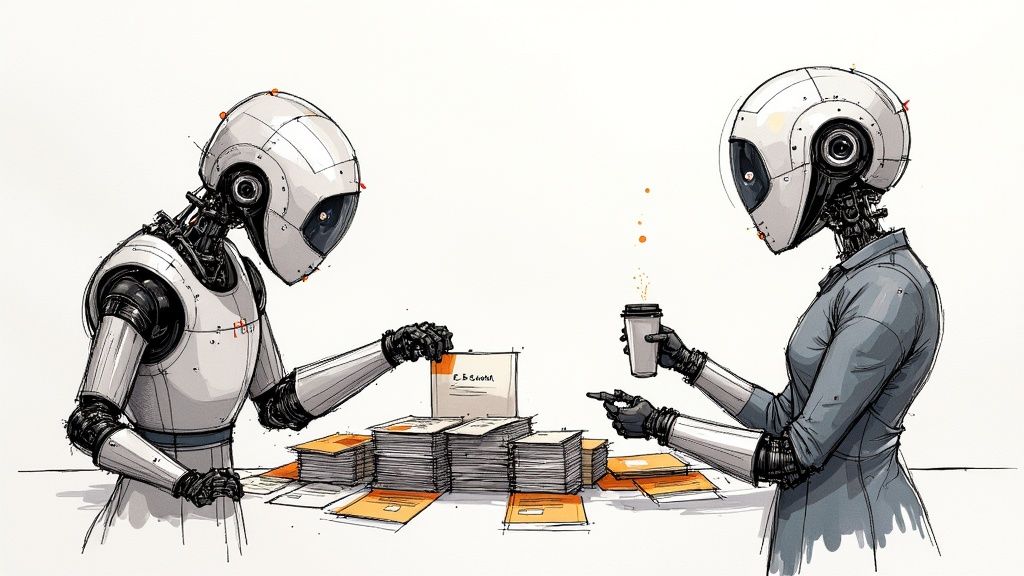
This isn't about letting Skynet make your hiring decisions. It's about using smart tools to handle the monotonous, high-volume parts of shortlisting candidates. Picture a system that instantly flags your deal-breakers and serves you a curated list of high-potential applicants before you've even had your first coffee.
The Superpower You Didn't Know You Had
Let's cut through the AI hype. Modern tools aren’t here to replace recruiters; they’re here to give them superpowers. The whole point is to automate the top of the funnel so you can spend your valuable time where it actually matters: talking to the interesting people.
This isn't just a theory. Unilever reported saving over £1 million annually after bringing AI into their screening process. This shift also slashed their recruiting time by a massive 75% while boosting employee retention and workforce diversity.
The right automation handles the grunt work. Powerful AI Agents for HR are purpose-built to take on exactly these kinds of repetitive tasks.
The point of automation isn't to remove the human element. It's to focus the human element on tasks that actually require judgment, empathy, and strategic thinking—things a machine can't do.
Think of it as having a tireless assistant who does all the prep work. This assistant never gets tired, never misses a detail, and never complains. Your job is to take the polished list they hand you and work your magic. Our guide on automated candidate screening breaks down exactly how to get this system in place.
What Automation Actually Looks Like
So, what are we really talking about here? It’s not some magic black box. It’s a set of practical tools designed to execute the rules you set.
Here’s what a smart, automated shortlisting process can do for you:
- Knockout Questions: Instantly filter out anyone who doesn't meet the non-negotiables. Does the job require a specific license? The system checks. No license, no pass. Simple.
- Skill Matching: Scan resumes for the essential skills you’ve defined. This isn't about finding buzzwords; it's about verifying the presence of core competencies needed for the role.
- One-Way Video Interviews: Instead of scheduling dozens of initial phone screens, send top candidates a link to record short video answers to your questions. This lets you assess communication skills and personality on your own schedule, without the calendar Tetris.
This approach transforms the shortlisting of candidates from a chaotic scramble into a proactive, orderly system. You stop being a resume bouncer and start being a talent strategist. Much better.
A Modern Shortlisting Workflow You Can Steal
Alright, theory is great, but a battle-tested plan is better. Let’s stop talking about what you could do and lay out a modern workflow for the shortlisting of candidates that you can implement tomorrow.
This isn't some rigid flowchart. Think of it as a framework that blends sharp human intuition with the raw power of automation. Forget the 'maybe' pile. This is about delivering a handful of 'hell yes' candidates to your hiring manager, fast.
This infographic breaks down the core philosophy—use automation to clear the noise so you can focus on the signal.
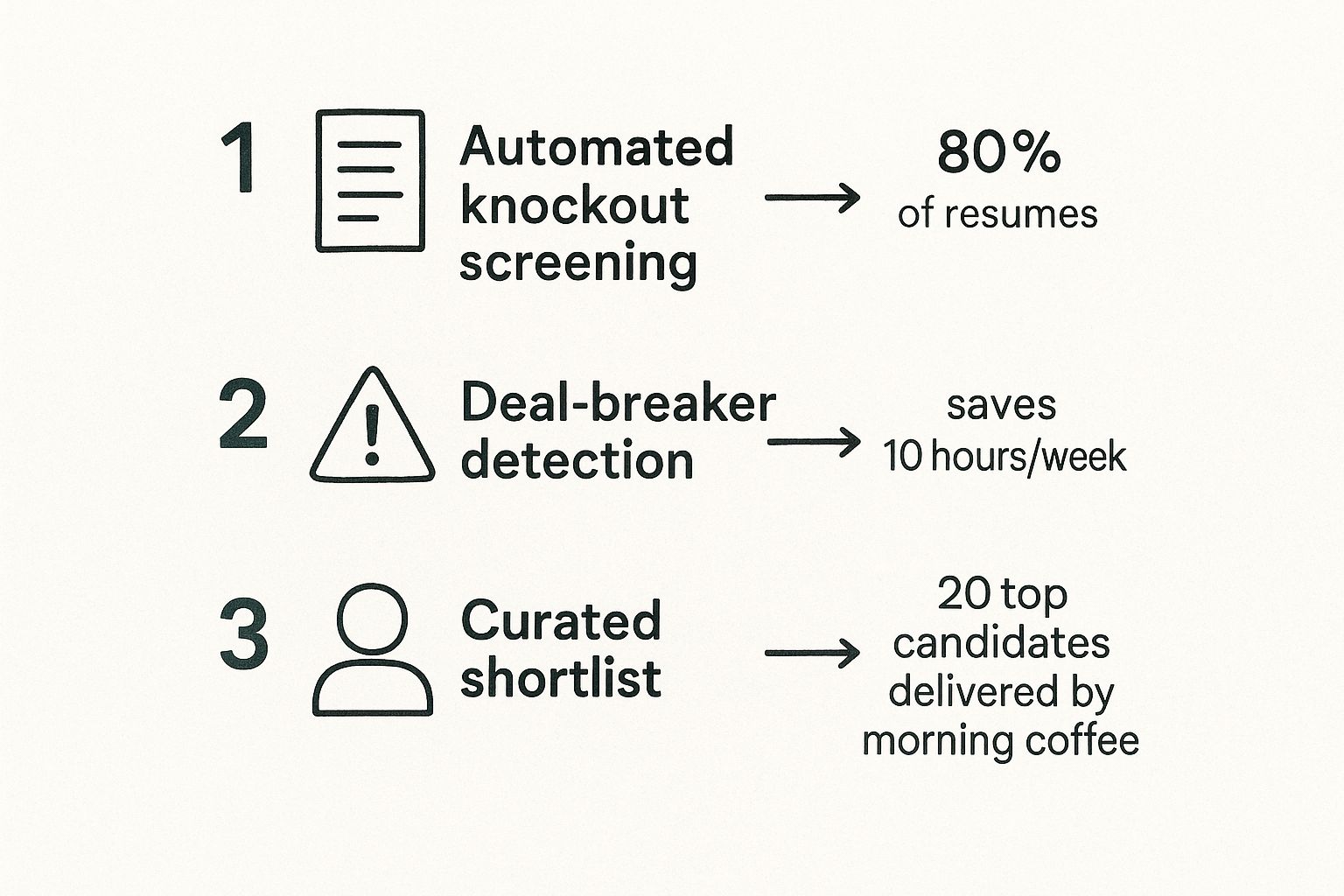
The key takeaway is simple: a huge chunk of your applicants should be filtered by machines. This pulls your team out of the administrative quicksand that kills momentum.
Step 1: The Automated Knockout Round
First, ruthlessly eliminate anyone who doesn't meet your baseline requirements. This is where you let the robots do the heavy lifting.
Set up knockout questions right in your application. These are simple, yes/no questions based on your non-negotiables.
- "Do you have the required [Specific Certification]?"
- "Are you legally authorized to work in [Country] without sponsorship?"
- "Are you proficient in [Must-Have Software]?"
If a candidate answers "no," they’re automatically filtered out. No human ever needs to see that application. This first pass alone can eliminate up to 80% of applicants. It sounds harsh, but it’s the kindest thing you can do for everyone's schedule.
Step 2: The One-Way Video Screen
Now you're working with a much smaller, more relevant pool. But a resume still doesn't tell you if someone can articulate a thought clearly. Before you commit to a live interview, use a one-way video screen.
Invite this filtered group to answer 2-3 targeted questions via recorded video. You're not judging their on-camera charisma; you're assessing core communication skills and getting a feel for their personality. You’ll be shocked at how much you can learn from a 90-second answer.
A one-way video screen is your secret weapon against the "great on paper, terrible in person" candidate. It’s the fastest way to gauge clarity of thought without the nightmare of scheduling a dozen phone calls.
Step 3: The Human Review and 'Hell Yes' List
Only now does a human being—a strategic recruiter or hiring manager—sit down to review the remaining profiles. They aren’t sifting through 100 resumes. They're looking at maybe 10-15 highly qualified candidates who have already passed both the automated and video screens.
At this stage, your team can finally do what they do best: apply nuance and intuition. They can compare the top contenders, review their video answers, and build that glorious shortlist of 3-5 people who are genuinely exciting.
This three-step workflow transforms the shortlisting of candidates from a painful chore into a strategic advantage. To really dial this in, explore the best tools for recruiters that can power this system. You’ll stop the candidate black hole and ensure you’re only talking to the absolute best.
Your Shortlisting Questions, Answered
Look, we get it. You're in the trenches, trying to build a killer team without losing your mind. Here are a few common questions we hear about shortlisting candidates, with some straight-up, no-fluff answers.
How Long Should This Actually Take?
There's no magic number, but let's be blunt: if it takes more than a week to get from application to an interview list, you're moving too slow.
The absolute best candidates are off the market in about 10 days. The goal isn't just speed; it's momentum. A modern process using automation for the grunt work should get you a qualified list within 48-72 hours. Any longer and you’re just giving your competitors a head start.
What’s the Ideal Shortlist Size?
Stop it with the "more is better" trap. Your hiring manager doesn't want to see 15 candidates; they want to see the 3-5 amazing ones who could all realistically get the job. Sending a long list just means you’re pushing your work onto them.
A tight, well-vetted shortlist of 3-5 people shows you've done your job. If you can't narrow it down that far, your screening criteria are too vague. Go back and define your non-negotiables.
A concise list forces clarity and makes the final decision infinitely easier. It’s about quality, not quantity. Period.
Can We Really Trust AI to Shortlist Fairly?
This is a totally valid concern. A badly implemented AI can be just as biased as a tired human. The key is understanding what automation is actually good for.
Use tools to handle the objective, binary stuff—the absolute knockout criteria.
- "Do you have the required PMP certification?" (Yes/No)
- "Are you proficient in Python?" (Yes/No)
This is where AI shines: handling repetitive, rule-based tasks at scale. Let automation do the tedious filtering, and save your team's brainpower for assessing nuanced things like problem-solving and communication. Think of AI as a powerful assistant, not the final judge.
Ready to stop drowning in resumes and start building a smarter, faster hiring process? Async Interview automates the tedious parts of shortlisting so you can focus on what really matters: talking to great people. Discover how you can hire up to 10x faster.
